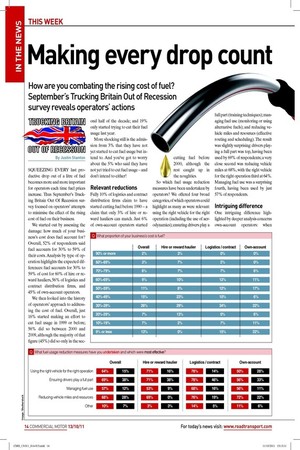Making every drop count
Page 11

Page 12

If you've noticed an error in this article please click here to report it so we can fix it.
How are you combating the rising cost of fuel? September’s Trucking Britain Out of Recession survey reveals operators’ actions
SQUEEZING EVERY last productive drop out of a litre of fuel becomes more and more important for operators each time fuel prices increase. Thus September’s Trucking Britain Out Of Recession survey focused on operators’ attempts to minimise the effect of the rising cost of fuel on their business.
We started out by assessing the damage: how much of your business’s cost does fuel account for? Overall, 52% of respondents said fuel accounts for 30% to 59% of their costs. Analysis by type of operation highlights the expected differences: fuel accounts for 30% to 59% of cost for 60% of hire or reward hauliers, 56% of logistics and contract distribution irms, and 45% of own-account operators.
We then looked into the history of operators’ approach to addressing the cost of fuel. Overall, just 16% started making an effort to cut fuel usage in 1999 or before; 56% did so between 2000 and 2009, although the majority of that igure (45%) did so only in the sec
ond half of the decade; and 19% only started trying to cut their fuel usage last year.
More shocking still is the admission from 3% that they have not yet started to cut fuel usage but intend to. And you’ve got to worry about the 5% who said they have not yet tried to cut fuel usage – and don’t intend to either!
Relevant reductions
Fully 10% of logistics and contract distribution irms claim to have started cutting fuel before 1990 – a claim that only 3% of hire or reward hauliers can match. Just 6% of own-account operators started cutting fuel before 2000, although the rest caught up in the noughties.
So which fuel usage reduction measures have been undertaken by operators? We offered four broad categories, of which operators could highlight as many as were relevant: using the right vehicle for the right operation (including the use of aerodynamics); ensuring drivers play a full part (training techniques); managing fuel use (monitoring or using alternative fuels); and reducing vehicle miles and resources (effective routing and scheduling). The result was slightly surprising: drivers playing a full part was top, having been used by 69% of respondents; a very close second was reducing vehicle miles at 68%, with the right vehicle for the right operation third at 64%. Managing fuel use was a surprising fourth, having been used by just 57% of respondents.
Intriguing difference
One intriguing difference highlighted by deeper analysis concerns own-account operators: when transport is just a cost centre and not a proit centre, you think differently – while reducing vehicle miles was the third most popular measure among hire or reward hauliers, and for logistics and contract distribution irms, among own-account operators it was the most popular.
Conversely, using the right vehicle was most popular for hire or reward hauliers, and for logistics and contract distribution irms, but the least popular among own-account operators.
But which of the measures was most effective? Well, it’s not that surprising to ind that the most effective measure maps almost precisely with the most popular: so drivers playing a full part is the most effective. Once again ownaccount operators go their own way: while reducing vehicle miles was their most popular measure, it was only their third most effective.
The verbatim statements reveal more about the most effective measures: ● “The more aerodynamics you can put on a vehicle, the better the fuel savings, like sideskirts on tractor units and full-length skirts on trailers, equal an mpg increase of at least 10% to 15%, and keeping the engine revs in the upper part of the green segment on the rev counter and better use of cruise control (if itted) [help].”
Healthy competition
● “Steering trailer axles and carefully matched combinations save 8%.” ● “We are lucky in that we have good drivers who respond well to the video training. Regular trip mpgs also play a part – we have a bit of a competition as to who gets the best igures!” ● “The SAFED training course has shown a marked improvement in fuel eficiency by all drivers who went on the course.” ● “Make [drivers] aware of what it costs to run a truck – cost of damage, tyres, fuel etc; make them understand that I can’t spend it on those and a pay rise as well.” ● “Drivers are more conscious of their role in cost reductions and the impact they can have.”
Route analysis
● “By introducing a driver-training programe, we have managed to reduce the amount of fuel used. We are achieving an extra 1mpg.” ● “It has made us look again at long-established routes that actually could be improved on by a rationalisation of drop points and movement of customers between supplying locations.” ● “50% of our services are now shared user, which increase revenue and proit.”
● “The use of dual-fuel has cut our overall fuel cost and greatly reduced our carbon footprint. There's a further gain by using CNG: our customers love it!” n
FOR THE LATEST NEWS VISIT:
www.roadtransport.com













































